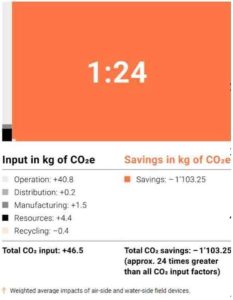Box: Our Answer to Megatrends
Five megatrends account for structural growth drivers in the Belimo core markets: energy efficiency, climate change, urbanisation, safety in buildings, and digitization.
Energy Efficiency: Smart Controls
As buildings currently consume 40% of the world’s energy, with HVAC systems accounting for 40% of that figure, smart control of HVAC systems has a significant impact on global energy efficiency. In most regions of the world, regulations increasingly support raising energy efficiency standards for HVAC equipment and encouraging energy-efficiency-driven building renovations. Here, Belimo products are making a difference.
Climate Change: Energy-Efficient HVAC Solutions
Climate change affects all of us. As our field devices help to reduce CO2 emissions from buildings’ HVAC systems, Belimo has a particularly strong commitment to helping limit global warming to less than 1.5°C.
Until we transition to a carbon-free economy, however, we will have to adjust to living on a warmer planet with more extreme heat. Already today, an estimated two-thirds of the global energy consumption of HVAC systems is used for cooling applications and only one-third for heating applications. A hotter global climate, in combination with continuously tighter building envelopes, means the shift of global energy demand from heating towards cooling will continue. Although better-insulated buildings lower the primary energy input, they also increase the need for ventilation, which is where Belimo field devices contribute to energy-efficient solutions.
Urbanisation: Well-Being and Indoor Air Quality
As populations shift across the globe from rural to urban areas, more and more people are leading modern, urban lifestyles and are spending 90% of their time indoors. State-of-the-art building automation and reliable HVAC components are indispensable for satisfying increasing demands for pleasant room climates and healthy environments.
Safety in Buildings: Protecting Lives and Assets
Urbanisation means more buildings on less land or smaller footprints with unusual designs, mixed uses, and increasing complexity. This poses new challenges for protecting lives and assets, making technical fire protection through motorised fire and smoke control dampers more important than ever before. At the same time, high-performance HVAC systems and proper humidification strategies are required to maintain stable, safe, and healthy indoor air quality.
Digitization: Embracing the Age of Transparency
Digitization in the building automation industry offers new powerful toolsets for analysing and optimising HVAC systems. The applications for smart performance devices are seemingly endless, whether they be in the form of data analytics, monitoring, predictive maintenance, ease of installation, or digital support during the commissioning and system integration phases.












